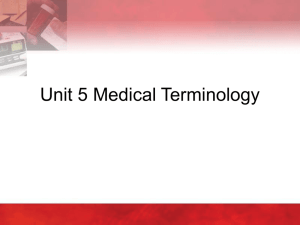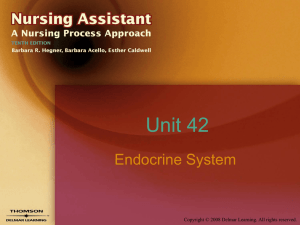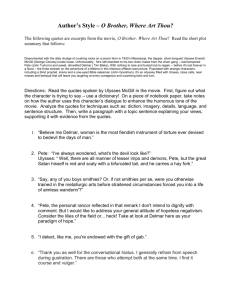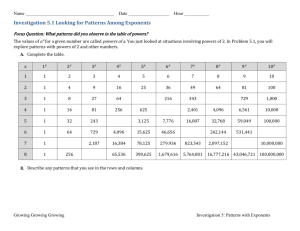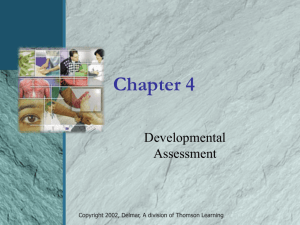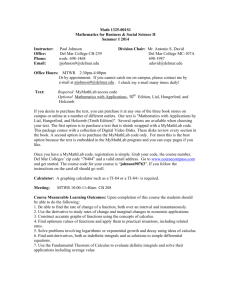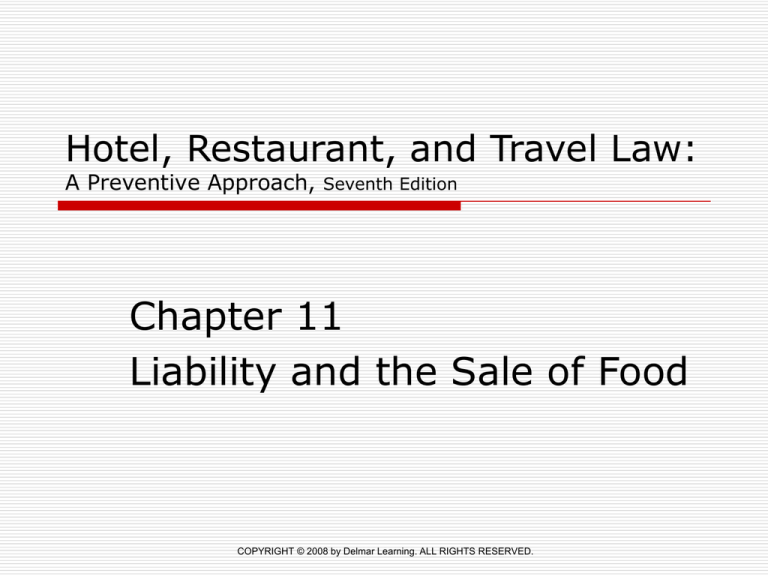
Hotel, Restaurant, and Travel Law:
A Preventive Approach,
Seventh Edition
Chapter 11
Liability and the Sale of Food
COPYRIGHT © 2008 by Delmar Learning. ALL RIGHTS RESERVED.
Introduction
One out of every three meals is eaten
away from home
If restaurants serve unhealthy food, a
serious health risk results
Law imposes liability on facilities that
serve tainted food and make claims
about food that are not truthful
COPYRIGHT © 2008 by Delmar Learning. ALL RIGHTS RESERVED.
Adulterated Food
Food that causes illness
Possible grounds on which to sue:
Breach of warrant of merchantability
Strict products liability
Negligence
COPYRIGHT © 2008 by Delmar Learning. ALL RIGHTS RESERVED.
Warrant of Merchantability
Uniform Commercial Code (UCC)—rules
to simplify and modernize law
governing sale of goods, including
food
Implied warrant that goods are
“merchantable”
COPYRIGHT © 2008 by Delmar Learning. ALL RIGHTS RESERVED.
Warrant of Merchantability
(continued)
Merchantable—goods are fit for ordinary
purpose and are at least of average quality
Exists even if parties never mention it in
negotiations
Renders manufacturers and sellers of food
virtual insurers that food is safe to eat
COPYRIGHT © 2008 by Delmar Learning. ALL RIGHTS RESERVED.
Merchantable Food
Must be fit for human consumption, will not
make people ill who eat it
Does not have to be nutritional or taste
good, just eatable
Inappropriate objects in food make it
unmerchantable
As does food infected with harmful bacteria
or virus, spoiled, and undercooked
COPYRIGHT © 2008 by Delmar Learning. ALL RIGHTS RESERVED.
Objects in Food
Foreign/Natural substance test—
unrelated to the components or
ingredients of the product
Reasonable expectation test—object
found in food ought to have been
anticipated by the consumer
COPYRIGHT © 2008 by Delmar Learning. ALL RIGHTS RESERVED.
Objects in Food
(continued)
More situations under reasonable
expectation than foreign/natural test
Some objects are natural but
unexpected
COPYRIGHT © 2008 by Delmar Learning. ALL RIGHTS RESERVED.
Trend toward Reasonable
Expectation Test
Courts are favoring reasonable
expectation over strict application of
foreign/natural test
Even presence of natural substances
can render food unfit
COPYRIGHT © 2008 by Delmar Learning. ALL RIGHTS RESERVED.
Other Grounds for Breach of
Warrant of Merchantability
Foreign or unexpected objects in food are
not only basis for liability based on the sale
of food
Rancid or spoiled food
Adulterated or contaminated food
Improper handling and preparation
Time and temperature abuse
Significantly burned food
If food is unfit, warrant of merchantability
is breached
COPYRIGHT © 2008 by Delmar Learning. ALL RIGHTS RESERVED.
Class Action
Proceeding pursued on behalf of
many people injured by the same
cause with common legal issues
Less expensive and easier to
participate by plaintiffs
Expands liability exposure of
defendant
COPYRIGHT © 2008 by Delmar Learning. ALL RIGHTS RESERVED.
Hot Beverages
Exercise caution when serving hot
beverages
To protect patrons from injury, a
restaurant should take several
precautions
COPYRIGHT © 2008 by Delmar Learning. ALL RIGHTS RESERVED.
Hot Beverages
(continued)
Precautions:
Drinks should be served at temperature
in line with industry standards
Coffee and tea makers can be preset to
safe-to-drink temperatures
Lids should be provided for carryouts
At buffets, diners should have the option
of putting a cap on cups
COPYRIGHT © 2008 by Delmar Learning. ALL RIGHTS RESERVED.
Hot Beverages
Precautions:
(continued)
(continued)
Lids should have lift-off tabs for sugar
and cream to be added
Wait staff should avoid placing hot
beverages near a child
Warn customer verbally and/or put
warning on cup
COPYRIGHT © 2008 by Delmar Learning. ALL RIGHTS RESERVED.
Foodborne Illnesses
Illnesses caused by consuming foods
or beverages contaminated with
bacteria, viruses, and parasites
Proper handling will usually eliminate
risks
COPYRIGHT © 2008 by Delmar Learning. ALL RIGHTS RESERVED.
Foodborne Illnesses
(continued)
Proper sanitation and cooking will greatly
reduce risk of:
Salmonella infection
E. coli—bacterium in foods, especially uncooked
or undercooked beef
Trichinosis—illness caused by eating raw or
undercooked pork and wild game
Once quite common, now relatively rare
Now more associated with raw or undercooked
game meats
Chefs and kitchen staff should have
adequate training in food safety
COPYRIGHT © 2008 by Delmar Learning. ALL RIGHTS RESERVED.
Proof Problems Establishing
Causation
Plaintiff must prove that food
purchased at the defendant’s
establishment was the cause of the
illness
Must prove that food purchased was
unwholesome
COPYRIGHT © 2008 by Delmar Learning. ALL RIGHTS RESERVED.
Privity of Contract
Under common law, a direct
contractual relationship was required
between the plaintiff and defendant in
a breach of warranty action
Privity of contract—relationship
between parties to a contract
COPYRIGHT © 2008 by Delmar Learning. ALL RIGHTS RESERVED.
Strict Products Liability
Based in tort law rather than contract
Plaintiff must prove three elements:
Defendant sold product in defective
condition
Plaintiff was injured
Injury was caused by the defect
COPYRIGHT © 2008 by Delmar Learning. ALL RIGHTS RESERVED.
Strict Products Liability
(continued)
Eliminates the requirement of privity
Enhances a plaintiff’s chances of
success in a lawsuit based on
defective food
COPYRIGHT © 2008 by Delmar Learning. ALL RIGHTS RESERVED.
Strict Products Liability
(continued)
If diner becomes ill from food, but:
cause is inherent in the food
it poses no threat to most people
the restaurant took precautionary
measures to protect diners
food will not be considered defective
COPYRIGHT © 2008 by Delmar Learning. ALL RIGHTS RESERVED.
Statutory Violations
Various state statutes require
restaurateurs to follow specified
mandates in the preparation of food
In a Washington case, a state law
required restaurants to warn patrons
of known risks associated with food
products
COPYRIGHT © 2008 by Delmar Learning. ALL RIGHTS RESERVED.
Negligence
An injured diner claims the restaurant
was careless while preparing the food
That inattentiveness led to the meal
being tainted
COPYRIGHT © 2008 by Delmar Learning. ALL RIGHTS RESERVED.
Choice of Action
A diner who is served defective food
may have several bases on which to
sue:
Breach of warranty
Strict products liability
Statutory violation
Negligence
COPYRIGHT © 2008 by Delmar Learning. ALL RIGHTS RESERVED.
Customers with Allergies
Restaurant patrons frequently request
that certain ingredients be eliminated
from their food
Some requests are prompted by
allergies
COPYRIGHT © 2008 by Delmar Learning. ALL RIGHTS RESERVED.
Customers with Allergies
(continued)
Wise policy mandates that substitute
food be served on a clean dish
Small residue may be sufficient to
cause an allergic reaction
COPYRIGHT © 2008 by Delmar Learning. ALL RIGHTS RESERVED.
Food and Drug Administration
FDA—federal agency that oversees
food industry
Objectives include promoting public
health by ensuring that foods are:
Safe
Wholesome
Sanitary
Properly labeled
COPYRIGHT © 2008 by Delmar Learning. ALL RIGHTS RESERVED.
Food and Drug
Administration (continued)
Food Code—set of model ordinances
that provides guidance on standards
and practices for the achievement of
food safety in restaurants and other
segments of the food industry
COPYRIGHT © 2008 by Delmar Learning. ALL RIGHTS RESERVED.
Food and Drug
Administration (continued)
Hazard Analysis Critical Control Point
system (HACCP)
Quality assurance scheme to identify and
minimize spoilage and contamination
problems during food manufacturing and
service
Focuses on managing risk at each of 10
operating activities, control points,
common to all food service
establishments
COPYRIGHT © 2008 by Delmar Learning. ALL RIGHTS RESERVED.
Food and Drug
Administration (continued)
Among control methods utilized are:
Cooking
Refrigeration
Packaging
Monitoring
Employee handwashing
COPYRIGHT © 2008 by Delmar Learning. ALL RIGHTS RESERVED.
Food and Drug
Administration (continued)
Implementation is an essential
element of managing the operations
of a food-service facility
Adoption and compliance helps
prevent and mitigate legal liability for
defective food
COPYRIGHT © 2008 by Delmar Learning. ALL RIGHTS RESERVED.
Handwashing by Food Preparers
Critical control point
safety
(CCP)
in food
If food handlers (cooks and wait staff) come
to work ill, their illness may be
transferred to customers
COPYRIGHT © 2008 by Delmar Learning. ALL RIGHTS RESERVED.
Handwashing by Food Preparers
(continued)
Management should ensure that
employees are knowledgeable about
proper handwashing procedures
Signs in bathrooms should remind
employees to cleanse their hands
properly after using the facilities
COPYRIGHT © 2008 by Delmar Learning. ALL RIGHTS RESERVED.
False Food Claims
Restaurants often make claims about
the food they sell
Health or nutritional benefits
Methods of preparation
Law requires that claims must be
truthful
COPYRIGHT © 2008 by Delmar Learning. ALL RIGHTS RESERVED.
Truth-in-Menu Laws
Require accuracy in claims made by
restaurants about their food
Laws apply only to items that are
advertised with a nutrient or health
claim
Low fat
Heart healthy
COPYRIGHT © 2008 by Delmar Learning. ALL RIGHTS RESERVED.
Truth-in-Menu Laws
(continued)
Despite limited federal laws, many
restaurants are concerned about
State laws
Quality assurance
Consumer confidence
Most states have laws to eliminate
misleading food advertisements and
labels
COPYRIGHT © 2008 by Delmar Learning. ALL RIGHTS RESERVED.
Truth-in-Menu Laws
(continued)
Controversies can result from:
Omitting ingredients
Mistaking a product’s origin
Misdescribing a dish
Inaccurately identifying the cooking
method
COPYRIGHT © 2008 by Delmar Learning. ALL RIGHTS RESERVED.
Truth-in-Menu Laws
(continued)
Name of food product references a
geographical place that does not
denote place of origin and can be
used regardless of where food was
made
Swiss cheese
Kentucky Fried Chicken
COPYRIGHT © 2008 by Delmar Learning. ALL RIGHTS RESERVED.
Truth-in-Menu Laws
(continued)
Products that have been frozen
cannot be sold as “fresh”
Inaccurate cooking methods stated
on a menu should be corrected
COPYRIGHT © 2008 by Delmar Learning. ALL RIGHTS RESERVED.
Truth-in-Menu Laws
(continued)
Growing numbers of people are vegetarians
Fast-food chains are attempting to attract
these diners
What constitutes “vegetarian” is subject of
some dispute
To comply with the law and avoid customer
displeasure, restaurants must pay close
attention to accuracy in product descriptions
COPYRIGHT © 2008 by Delmar Learning. ALL RIGHTS RESERVED.
Obesity and Accuracy in Advertising
Obesity is often described as an
epidemic in this country
Many restaurants and food providers
are taking steps to ensure healthy
options
COPYRIGHT © 2008 by Delmar Learning. ALL RIGHTS RESERVED.
Obesity and Accuracy
in Advertising
(continued)
Nutritional information is available at
their establishments
Efforts by Congress to pass a bill
protecting eateries from obesityrelated lawsuits have not been
successful
COPYRIGHT © 2008 by Delmar Learning. ALL RIGHTS RESERVED.
Food Labeling
Public has become more concerned
about health issues
Cholesterol
Saturated fat intake
Health claims have become a
significant factor in consumers’ choice
of food products
COPYRIGHT © 2008 by Delmar Learning. ALL RIGHTS RESERVED.
Food Labeling
(continued)
Food producers try to capitalize on
customers’ interests in healthy foods
Nutritional Labeling and Education Act
of 1990
FDA has promulgated regulations to
enforce the Act
COPYRIGHT © 2008 by Delmar Learning. ALL RIGHTS RESERVED.
Application to Packaged Foods
Mandatory nutritional labels required
for all packaged foods
Act requires what information must
be on labels
COPYRIGHT © 2008 by Delmar Learning. ALL RIGHTS RESERVED.
Label Information Required
Standardization of serving sizes
Regulation/standardization of terms such as
light, cholesterol-free, and low calorie
Mandatory labeling of fat content by
weight, specifying both total fat and
saturated fat
Limitations on health claims
COPYRIGHT © 2008 by Delmar Learning. ALL RIGHTS RESERVED.
Label Information Required
(continued)
Mandatory labeling of fiber content by
weight
Mandatory labeling of following as
percentages of U.S. recommended RDA:
Total fat
Saturated fat
Cholesterol
Sodium
Carbohydrates
Fiber
COPYRIGHT © 2008 by Delmar Learning. ALL RIGHTS RESERVED.
Application to Restaurants
When a restaurant makes a claim about the
nutritional content or healthfulness of a
food product, it must provide to patrons,
upon their request, the information
required to be on a packaged food label
Information is not required to be on the
menu but must be available upon request
COPYRIGHT © 2008 by Delmar Learning. ALL RIGHTS RESERVED.
Application to Restaurants
(continued)
If a restaurant uses as descriptors of
its menu items any terms defined by
the Act, it must comply with those
definitions
COPYRIGHT © 2008 by Delmar Learning. ALL RIGHTS RESERVED.
Kosher Foods
A designation referring to food prepared
consistent with Jewish religious
requirements
Must be verified by a rabbi to receive
designation
People who “keep kosher” have a right to
expect that food advertised as kosher is
prepared as required
COPYRIGHT © 2008 by Delmar Learning. ALL RIGHTS RESERVED.
Kosher Foods
(continued)
Laws in most states prohibit
advertising food as kosher unless it is
Promoting non-kosher food as kosher
violates these laws
Many states treat such conduct as
criminal
COPYRIGHT © 2008 by Delmar Learning. ALL RIGHTS RESERVED.
Relationships between Fast-Food
Operations and Hotels
Expanded relationship developing
Relationship is a contractual one
According to contract, food is prepared by
hotel employees
Fast-food company has an interest in
ensuring that food is prepared in the same
manner as it is in restaurants
COPYRIGHT © 2008 by Delmar Learning. ALL RIGHTS RESERVED.
Relationships between Fast-Food
Operations and Hotels
(continued)
The hotel will be only party liable,
assuming a defect originated there
The hotel is not an agent of the food
company, and hotel employees are
not employees of the restaurant
COPYRIGHT © 2008 by Delmar Learning. ALL RIGHTS RESERVED.
Smoking Restrictions
Many states and localities restrict or
prohibit smoking in public buildings,
including restaurants
Based on findings that breathing
secondhand smoke is a significant
health hazard
COPYRIGHT © 2008 by Delmar Learning. ALL RIGHTS RESERVED.
Smoking Restrictions
(continued)
Danger applies to both customers and
more so to employees
Some states permit smoking in an
accessory bar
COPYRIGHT © 2008 by Delmar Learning. ALL RIGHTS RESERVED.
Smoking Restrictions
(continued)
Some restaurants cited for violating
smoking laws have challenged validity
on constitutional grounds
Generally statues are upheld as an
appropriate means to protect public
health
COPYRIGHT © 2008 by Delmar Learning. ALL RIGHTS RESERVED.
Safety Concerns Particular
to Food Preparation
Restaurateur has a duty to minimize
risks
Kitchens are inherently dangerous
Meat cutters
Grills
Deep-fat fryers
Knives
Stoves
COPYRIGHT © 2008 by Delmar Learning. ALL RIGHTS RESERVED.
Safety Concerns Particular
to Food Preparation
(continued)
Direct relationship between quality of
accident-prevention program and
frequency/severity of accidents
Managers must devise policies to
encourage safety
Employee training is imperative
COPYRIGHT © 2008 by Delmar Learning. ALL RIGHTS RESERVED.
Risks Associated with
Donated Foods
Restaurants may be motivated to give
leftover/unused food to a charitable
organization
Good managers will verify condition
of the food before it is donated to
employees or people in need
COPYRIGHT © 2008 by Delmar Learning. ALL RIGHTS RESERVED.
Liability for Injuries to Patients
Restaurateurs have a duty to protect
patrons from injury caused by other
customers when injury is foreseeable
Duty is breached and liability results
when a patron is disruptive and the
facility fails to eject that customer
COPYRIGHT © 2008 by Delmar Learning. ALL RIGHTS RESERVED.
Failure to Eject a Quarrelsome
Patron
If a patron is injured in a fight with
another customer, and it could have
been foreseen, the facility will be
liable
If employees are unable to remove a
troublemaker, call the police
COPYRIGHT © 2008 by Delmar Learning. ALL RIGHTS RESERVED.
Sudden Unforeseeable Attack
If a fight occurs suddenly, with no
warning, no liability results
If the owner cannot reasonably
foresee injury, the owner’s
responsibility to prevent attacks is
limited
COPYRIGHT © 2008 by Delmar Learning. ALL RIGHTS RESERVED.
Failure to Provide Adequate
Security
The facility may be liable if a patron is
injured and the facility failed to
provide staff adequate to police
premises
Attention to security issues is a must
to avoid liability
COPYRIGHT © 2008 by Delmar Learning. ALL RIGHTS RESERVED.
Failure to Provide Adequate
Security
(continued)
Protection plan should include
thorough training:
How to handle disturbances
Frequent assessment of foreseeable risks
Precautionary practices needed
COPYRIGHT © 2008 by Delmar Learning. ALL RIGHTS RESERVED.
No Duty to Comply with
Demands of Robber
Restaurateur has no duty to comply
with a robber’s unlawful demands
Even though compliance might lessen
danger to patrons on premises
COPYRIGHT © 2008 by Delmar Learning. ALL RIGHTS RESERVED.


